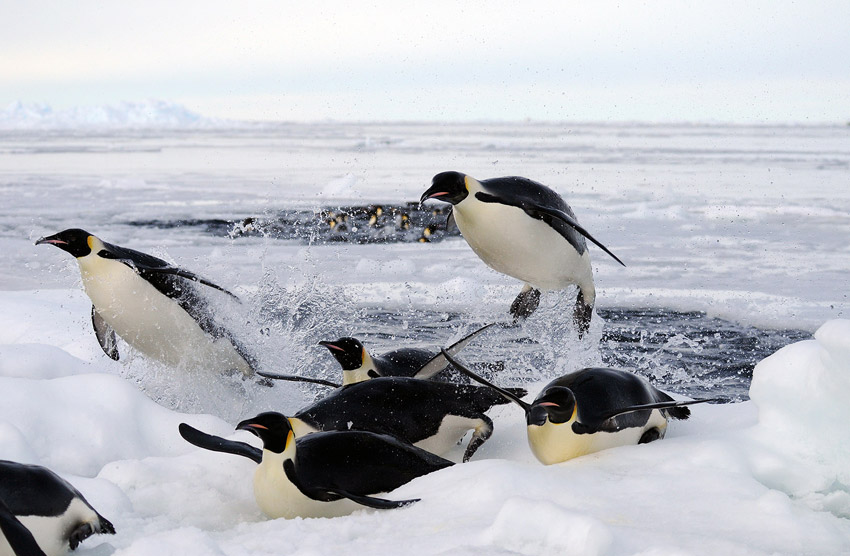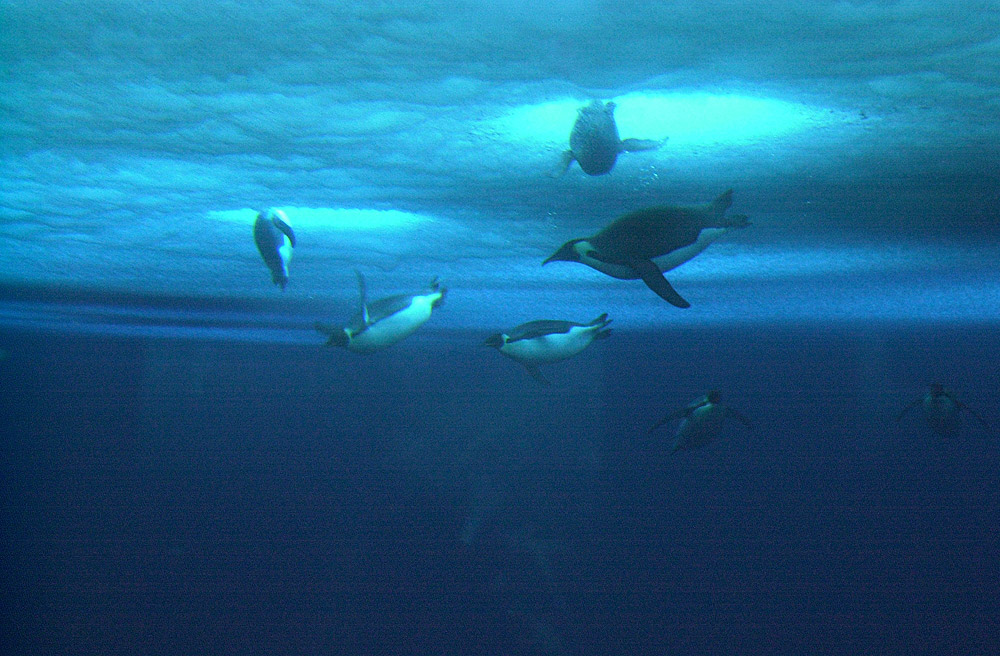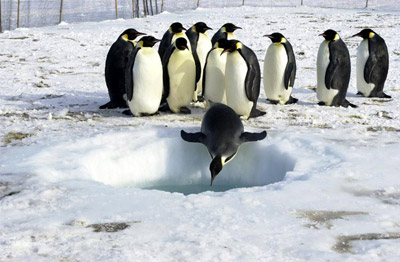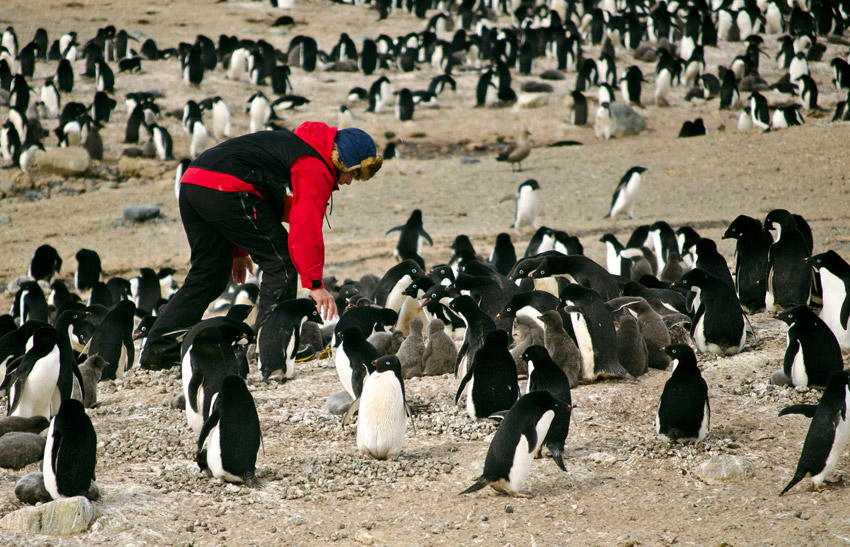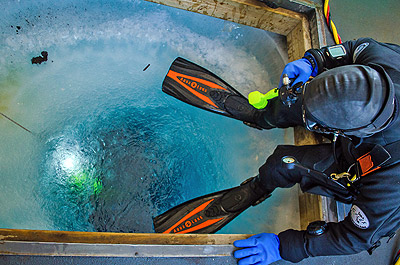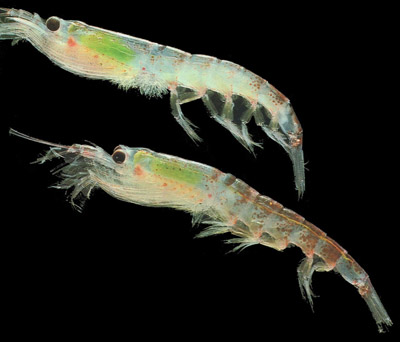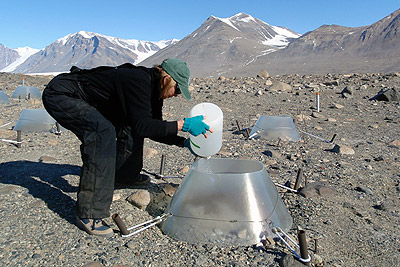Life Sciences, Biology in Antarctica
Antarctica has some of the most cold adapted organisms on the planet, how do they do it? and what can they teach us about the mechanisms of physiology and survival? Some of these organisms are already dealing with greater effects from climate change than anywhere else, how successfully are they doing this and what can we learn about how those elsewhere might cope?
Despite the cold Antarctica is home to a huge number of living organisms from the charismatic megafauna in all those great pictures you've seen to many small and intensively studied land invertebrates that you won't find unless you actively look for them, to a whole host of marine animals that we are discovering are more numerous and diverse than we ever thought.
The biological sciences can be carried out virtually anywhere in Antarctica. While some projects require great resources of ice strengthened ships to venture to remote areas with unpredictable sea-ice and the use of robot submersibles, others can be operated by a single researcher on a scientific station with little specialist equipment such as measuring long term trends in penguin populations to collecting and recording samples for analysis back further north in the home-country labs.
Here are some life science research projects taking place now or recently in Antarctica.
A Weddell seal with a camera and data recorder. This films what the seal sees when diving, it also measures depth and position and sends a three dimensional record of the seal's dives. With satellite connectivity such data recorders are now used through the winter months and record information such as temperature and salinity too. The seals are recruited as scientists to gather data at times when it was previously impossible.
The recorders are fixed in place with glue, they don't harm the seals at all and fall off after a few months.
Penguin Biology
There have been a great many studies on penguins starting in the earliest days of Antarctic exploration when expeditions would find often as not that there was a penguin colony within a short walk of their hut if not actually on their doorstep. Penguins are highly visible and widespread animals in the Antarctic, they show little or no fear of man and are generally indifferent to human presence whether it be a nearby scientific station or researchers or tourists walking nearby, they feed at sea and nest in large colonies on land. Put all these things together and they become animals that are almost going out of their way to make it easy to study them.
Penguin Ranch
The name given to a research facility about 15 miles out from McMurdo Station, holes cut in the ice allow access to the sea for non-breeding Emperor penguins which were taken there to study their diving physiology. Surrounding the holes is a fence which keeps the penguins in place for the study period of about two months, they can enter and leave the water freely for feeding but it is too far from open water or other holes or cracks for them to leave until they are released. more here
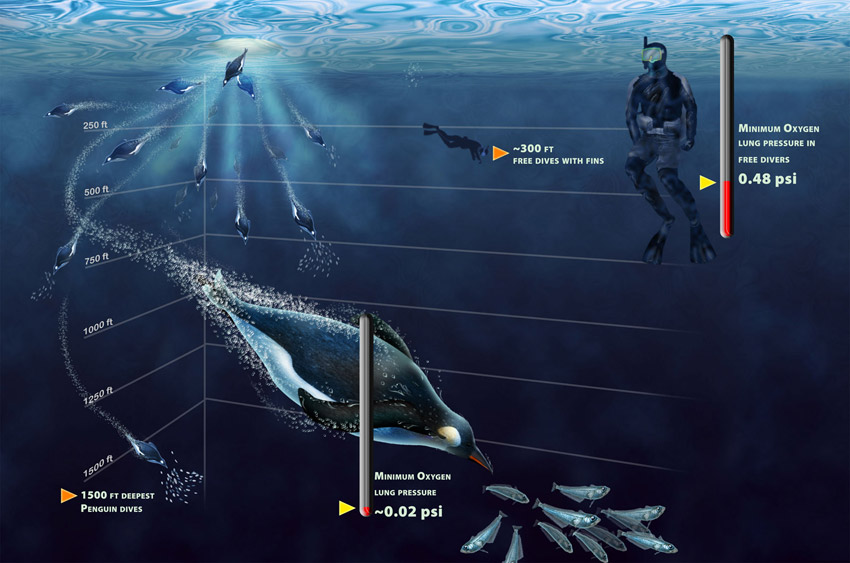
Diving physiology
in emperor penguins
An emperor penguin's heart-beat goes up from 60-70 beats per minute (bpm), to 180-200 bpm immediately before a dive as they load up blood and muscle with oxygen, on hitting the water, this drops to 100 bpm and then slows to just 20 bpm for most of the dive. They used stored oxygen in the blood and muscles during the dive, with no ability to get more from the lungs, there is no need for a fast heartbeat. Back at the surface, the rate goes up to 200 bpm to pay back the "oxygen debt" they have incurred during the dive, dumping accumulated carbon dioxide and topping up oxygen carriers again.
Long term colony studies and counting from a distance
Penguins are higher predators in their food chain, they feed on seafood, mainly fish and krill. Different species can have different feeding strategies, deep or shallow dives, near-shore or off-shore and may seek out different prey species. As well as studies that tell us about the biology of the penguins themselves directly, longer term studies on established penguin nesting sites (that have been shown to be hundreds or even thousands of years old) can tell us about what is happening further down the food chain as well as penguin populations and breeding success are connected with food availability.
Records are taken of the weights of birds arriving on the breeding grounds in spring, of the day when the first egg is laid, of the weight of fledgling chicks, of success in rearing chicks and of the populations of areas both large and small. more here
Penguin counting at a distance - Antarctica is a big place, it's a continent, if it was a country it would be the second biggest after Russia and about 40% larger than Canada the second largest country, It is also by far the least populated continent and so sometimes big things can go un-noticed, such as penguin colonies. Emperor penguin colonies in particular can be difficult to see as they are on sea-ice and are only occupied during the breeding season, outside of this there are no birds and the ice may break up and float away, at least land-based colonies are still recognisable even if the birds aren't there.
Many emperor penguins breeding colonies are in Eastern Antarctica which is the least densely populated and most rarely visited region of an already very sparsely populated and little visited continent. In recent years one of the best ways of identifying remote colonies is from space. The colonies are identifiable from the guano (poo) that colours the ice an unpleasant greenish yellow colour. In the duration of a colony, the penguin group may shift about over quite a large area so covering a huge area with guano that makes them visible on satellite photographs. A number of previously unknown colonies have been spotted in this way, and the existence of old colonies last visited decades ago has been verified or otherwise by more recent photographs.
As recently as March 2018 and in the far more frequently visited Antarctic Peninsula region, a huge and previously unknown Adelie penguin colony of about 1.5 million birds was reported at the excitingly named, and very difficult to reach Danger Islands. Once spotted from space, a team was sent by sea to investigate the colonies further. more here
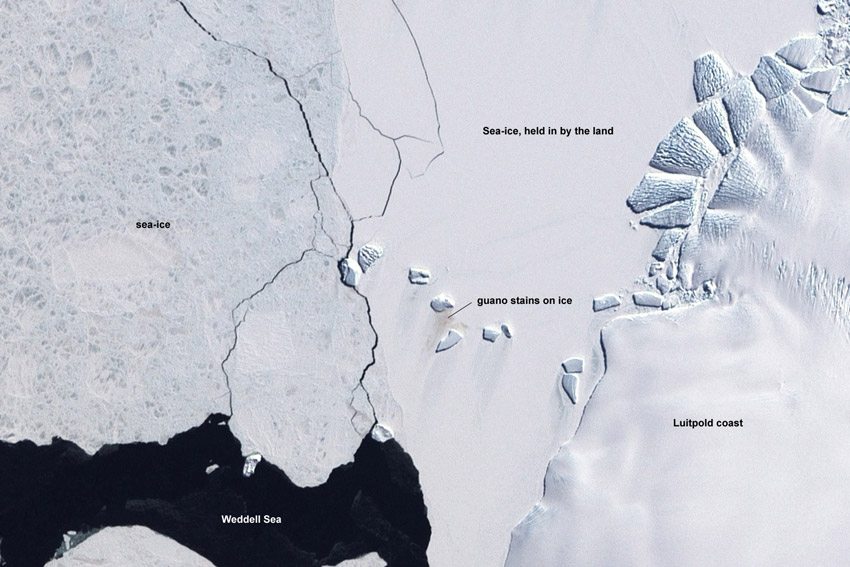
An emperor penguin
colony as seen by a satellite

Emperor penguins on sea ice during
the breeding season
Marine Invertebrates
Antarctica on the surface can often be a landscape of black, white and shades of blue. Beneath the sea however, this can become a brightly colourful world with a great biodiversity of marine invertebrates in particular that in recent years has been found to go against the long prevailing view that the ecosystem diversity was much less than in warmer waters. There are many studies on these organisms.
Krill is the subject of much Antarctic research - it is eaten by many other animals, whether entirely marine such as fish, squid and whales, or land going animals that feed at sea such as penguins and seals. Krill is also caught in large quantities by commercial fisheries. It is important to assess the world-wide population and how it changes with time as the knock-on effects of krill populations are important to the entire Antarctic ecosystem. Krill numbers are measured, or rather estimated as they are spread over a huge area throughout the water column and are constantly moving, by catching from ships and building up mathematical models which are added to and refined as more is found out about them. more here | and here
Krill have also been found to be important in the global carbon cycle with effects for climate change. They feed at the surface, taking in carbon as food and then slowly parachute downwards when it goes through their system and they poop out the waste at greater depth where the carbon stays over a much longer time period, they are responsible for a method of long term carbon capture.
Benthos underneath exposed ice shelves - Benthic organisms, or the benthos are bottom dwelling animals that may be static and fixed in place like sponges and mussels, or mobile like sea-stars and worms. It is known that there are communities of animals under ice shelves because they have been seen by using cameras on remote controlled submersibles or underwater drones. With the calving of huge ice bergs from ice shelves such as happened at the Larsen C shelf in the Weddell Sea in 2017, there are opportunities to study the exposed benthos more directly from ships. This was planned to take place in February 2018 but the survey ship, the RRS James Clark Ross was unable to reach the area of the ice shelf due to very heavy sea-ice and so the sampling on this occasion was abandoned and another area was studied instead. An example of how conditions in Antarctica can dictate what work can be done. more here
Lakes and Dry Valleys
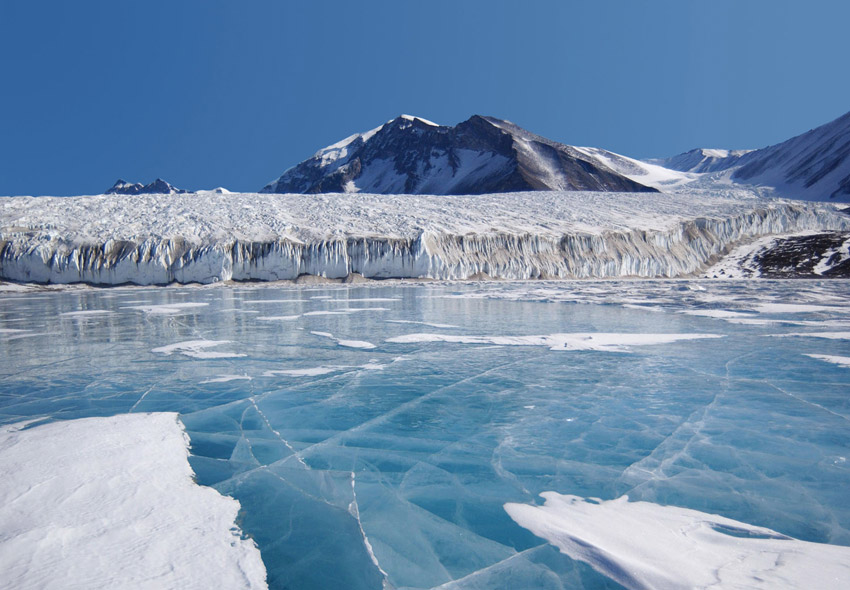
Lake
Fryxell, fed by summer meltwater from the Canada Glacier
seen behind the lake.
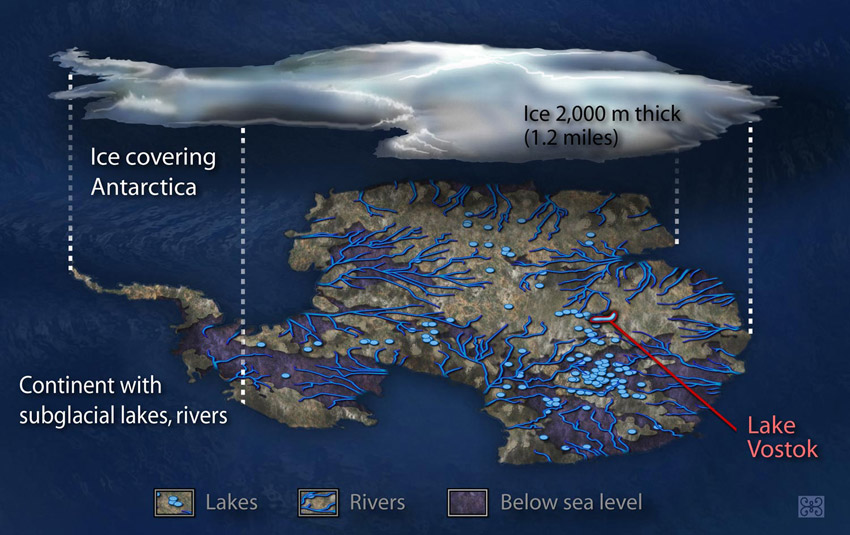
Sub
glacial lakes and rivers under the Antarctic ice cap,
the lakes can be detected, rivers are largely summized rather
than proven
A long standing study across much of Antarctica is that of Limnology. This is the study of inland waters, everything other than the sea. In Antarctica this usually means freshwater lakes and ponds which are frozen over for part or all of the year, it is a multi-disciplinary study encompassing biology, chemistry, physics and geology, all of which affect the characteristics of the water bodies over time.
Lakes and ponds anywhere offer an opportunity to study fairly easily an enclosed microcosm that is relatively little influnced from the outside, those in Antarctica are minimally affected by the activities of man compared to the rest of the world and are almost ideal study subjects as changes here can be detected that would be masked elsewhere.
Some Antarctic lakes are seen as sentinels of the effects of climate change, as temperature changes can be 2-3 times that of surrounding areas.
Like anywhere, lakes in Antarctica can vary enormously in size from less than a metre in depth to several hundred metres and from a few square metres to many square kilometres. The largest lake in Antarctica is Lake Vostok which is deep inland, it averages 430m meters deep and has a surface are of about 12,500 square kilometres, it is particularly difficult to visit however as it is covered by about 4km of ice, the lake itself is situated beneath the Antarctic ice cap and the bedrock, it is the world's sixth largest lake by volume and is one of 400 so far known lakes found beneath the ice. It is thought that these lakes may be interconnected to some extent by under-ice seasonal rivers.


